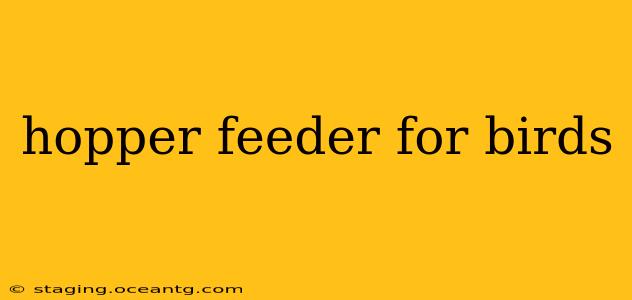Attracting birds to your backyard is a rewarding experience, offering a delightful connection with nature. A crucial element in successful bird feeding is choosing the right feeder, and hopper feeders are a popular and effective choice. This comprehensive guide delves into the world of hopper feeders, exploring their benefits, types, and how to choose the best one for your feathered friends and your yard.
What is a Hopper Bird Feeder?
Hopper feeders are designed with a large, enclosed container at the top that holds a substantial amount of birdseed. This seed is dispensed through multiple feeding ports, allowing several birds to feed simultaneously without overcrowding. The covered design also helps protect the seed from the elements, such as rain and snow, keeping it fresh and dry for longer periods. This makes them a practical and efficient choice for providing consistent food for your avian visitors.
What are the Benefits of Using a Hopper Bird Feeder?
Hopper feeders offer numerous advantages over other feeder types:
- Capacity: Their large capacity means less frequent refilling, saving you time and effort.
- Weather Protection: The covered design protects the seed from moisture and spoilage.
- Multiple Feeding Ports: Allows multiple birds to feed at once, minimizing competition and aggression.
- Variety of Seeds: Most hopper feeders can accommodate various seed types, catering to different bird species.
- Easy Cleaning: Many hopper feeders are designed for easy access and cleaning.
What Types of Hopper Bird Feeders are Available?
The market offers a wide range of hopper feeders, each with its own unique features:
- Basic Hopper Feeders: These are simple, affordable designs, perfect for beginners.
- Large Capacity Hopper Feeders: Ideal for areas with a high concentration of birds or those wanting to refill less frequently.
- Hopper Feeders with Perches: Provide perches for birds to comfortably feed.
- Squirrel-Resistant Hopper Feeders: Incorporate features to deter squirrels from accessing the seed. These often include baffles, weight-activated closures, or specialized hanging mechanisms.
- Window-Mounted Hopper Feeders: Allow for close-up birdwatching from the comfort of your home.
What Size Hopper Feeder Should I Choose?
The ideal size of your hopper feeder depends on several factors:
- Number of Birds: If you have many birds visiting your yard, a larger capacity feeder is recommended.
- Available Space: Consider the space you have available for mounting the feeder.
- Seed Type: Larger seeds like sunflower seeds might require wider feeding ports.
How Do I Clean a Hopper Bird Feeder?
Regular cleaning is essential to prevent the spread of disease among birds. Clean your hopper feeder at least once a month, or more frequently if necessary. Use warm soapy water to wash all parts thoroughly, rinse well, and allow to air dry completely before refilling.
What kind of seed should I use in a hopper feeder?
The best seed for your hopper feeder depends on the types of birds you want to attract. A mix of sunflower seeds (black oil sunflower seeds are a favorite), nyjer seed, and white-striped sunflower seeds is a good starting point. You can also add peanuts in the shell, cracked corn, or millet, depending on your local bird population.
How often should I refill my hopper feeder?
Refilling frequency depends on the size of your feeder, the number of birds visiting, and the type of seed used. Check your feeder daily and refill as needed. Keep an eye on seed levels to ensure birds always have access to food.
How do I prevent squirrels from getting into my hopper feeder?
Squirrels can be persistent and clever, but several strategies can deter them:
- Choose a squirrel-resistant design: Look for features like baffles, weight-activated closures, or specialized hanging mechanisms.
- Use squirrel-proof cages: These cages surround the feeder, preventing squirrels from accessing it.
- Hang your feeder in a location that is difficult for squirrels to reach: Hang it from a sturdy branch, well away from trees and other climbing surfaces.
By understanding the different types of hopper bird feeders and following some simple guidelines, you can create a welcoming and enjoyable habitat for your feathered friends. Remember to choose a feeder appropriate to your needs and local bird species, and enjoy the beautiful spectacle of birds visiting your backyard!
